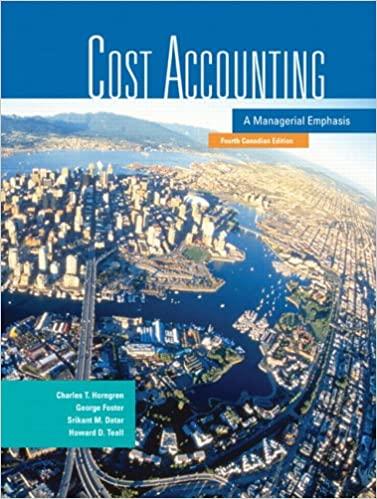Cost allocation downward demand spiral. Diversified Inc. is an industrial conglomerate operating in Western Canada. The conglomerate
Question:
Cost allocation downward demand spiral. Diversified Inc. is an industrial conglomerate operating in Western Canada. The conglomerate runs 14 companies in a diverse range of busi¬
nesses from its corporate headquarters in Vancouver. Diversified Inc. also runs a cleaning and maintenance company, Clean Shop Inc., from headquarters in Calgary. Clean Shop provides cleaning and maintenance services to all of Diversified’s facilities.
Clean Shop has the capacity to clean and maintain 5,000,000 square metres (m2) on a daily basis. Total floor space for all of Diversified’s facilities as of September 1, 2007, is 2,250,000 m2 (assume this is average floor space for 2007 in what follows). Bubba Smith, Clean Shop’s CEO, prepares the 2008 budget based on growth estimates from corporate headquarters. Bubba estimates an average 2,500,000 m2 will be cleaned and maintained daily during 2008. Facilities are operational 360 days a year.
For the six months ended June 30, 2007, Clean Shop incurred total costs of $64,800,000.
Fixed costs were $16,700,000. Bubba budgets fixed costs of $36,500,000 for 2008. Variable costs are projected to remain at 2007 levels. Bubba figures out what he will charge the subsidiary companies in 2008 (per square metre). He learns that, on average, competitors are charging
$0.14 per square metre for similar jobs.
As the year 2007 draws to a close,Johnson Almighty, CEO of Diversified, announces that all ofDiversified’s units will operate as profit centres beginningJanuary 1, 2008. Toward the end of December, Bubba learns that six ofthe 14 companies have decided to employ external thirdparty cleaning and maintenance services. The six companies account for 40% of projected 2008 floor space.
Required 1. What were Clean Shop’s variable costs per square metre in the first half of 2007? What are fixed costs allocated per square metre?
2. Before Almighty’s announcement, and assuming Bubba does not plan on margins, how much (per square metre) does Bubba plan to charge the subsidiary companies in 2008? Is this rate competitive? (using estimated square metres in the denominator level)
3. Using the cost-allocation techniques studied in this chapter, what accounting change could Bubba make to come up with a competitive rate?
4. Consider Almighty’s announcement. How much must Bubba charge the remaining com¬
panies per square metre to break even? How much will Clean Shop lose if Bubba does not change the rate per square metre as calculated in requirement 2? By how much would Bubba have to reduce capacity at Clean Shop to make the business competitive and break even? (Assume that any reduction in capacity will bring about a proportional reduction in fixed costs.)
5. Why wras 2007 capacity at Clean Shop more than double Diversified’s needs? Was Bubba operating in tire best interests of Diversified? Explain how surplus capacity at Clean Shop may have affected Diversified’s bottom line. What were the underlying accounting prac¬
tices that allowed such negligence to occur?
Step by Step Answer:

Cost Accounting A Managerial Emphasis
ISBN: 9780131971905
4th Canadian Edition
Authors: Charles T. Horngren, George Foster, Srikant M. Datar, Howard D. Teall





